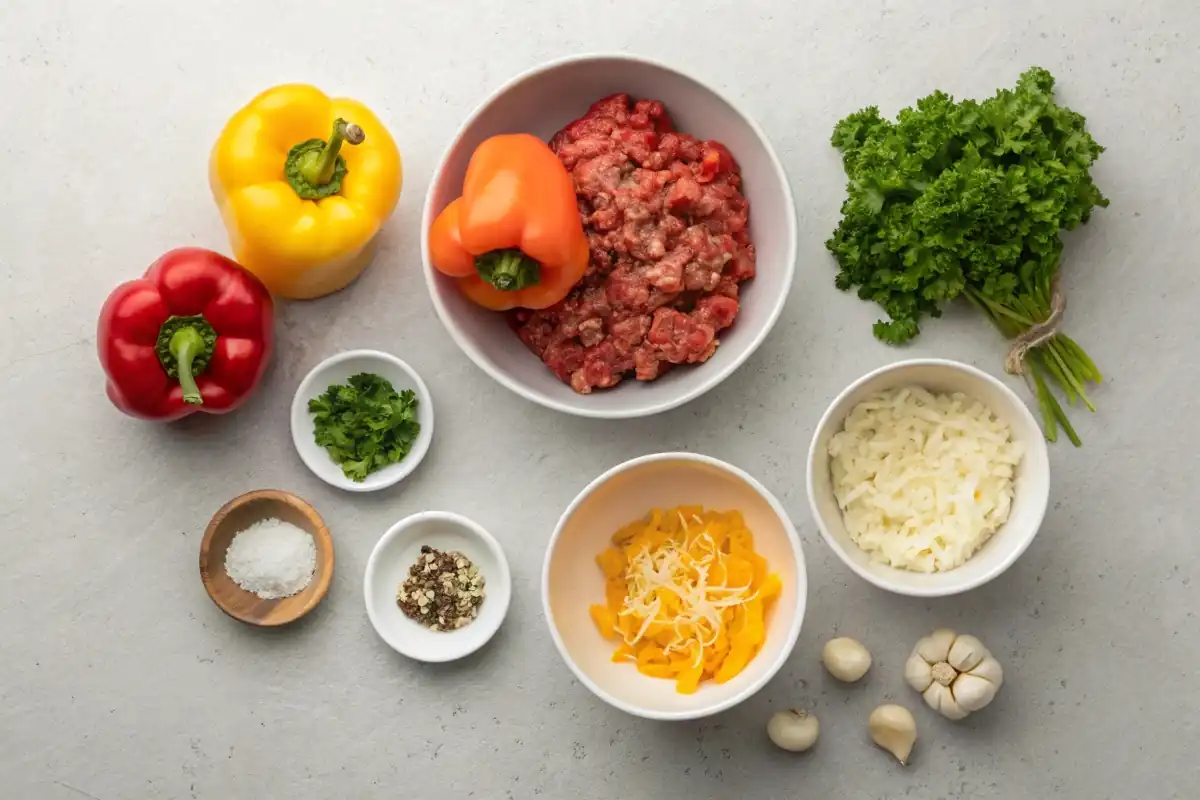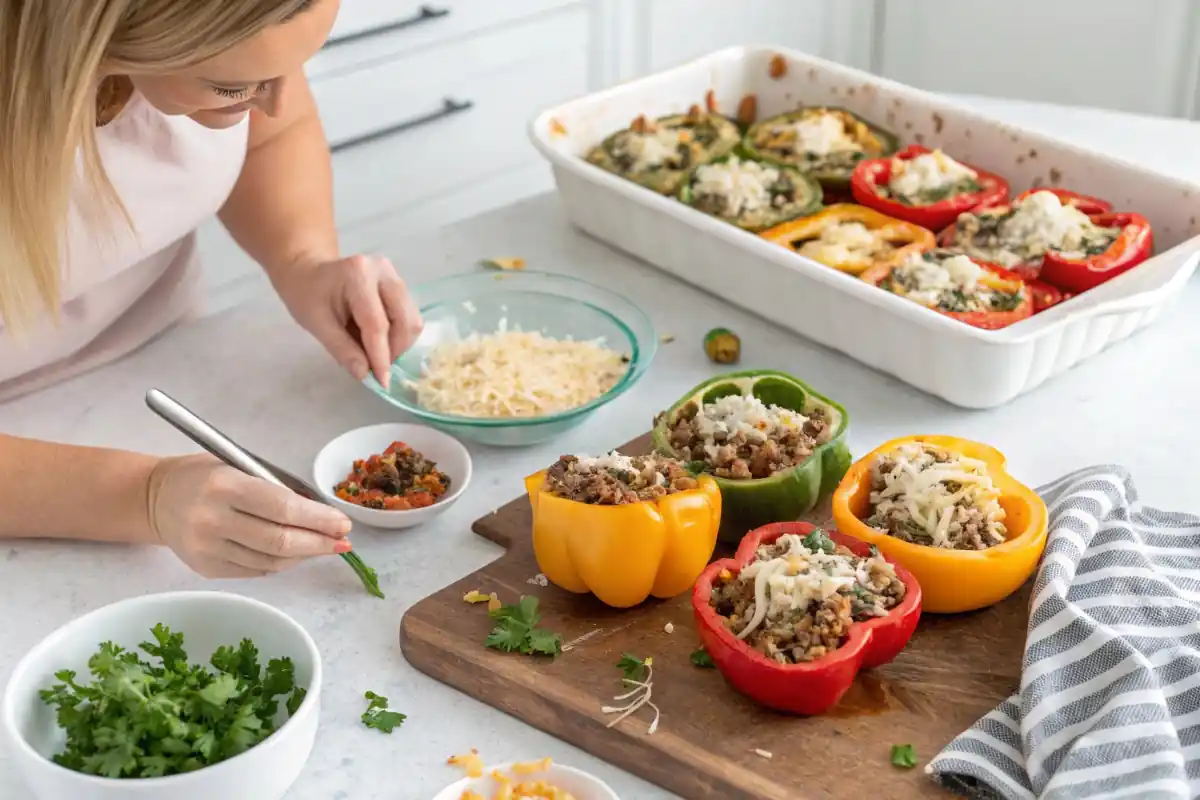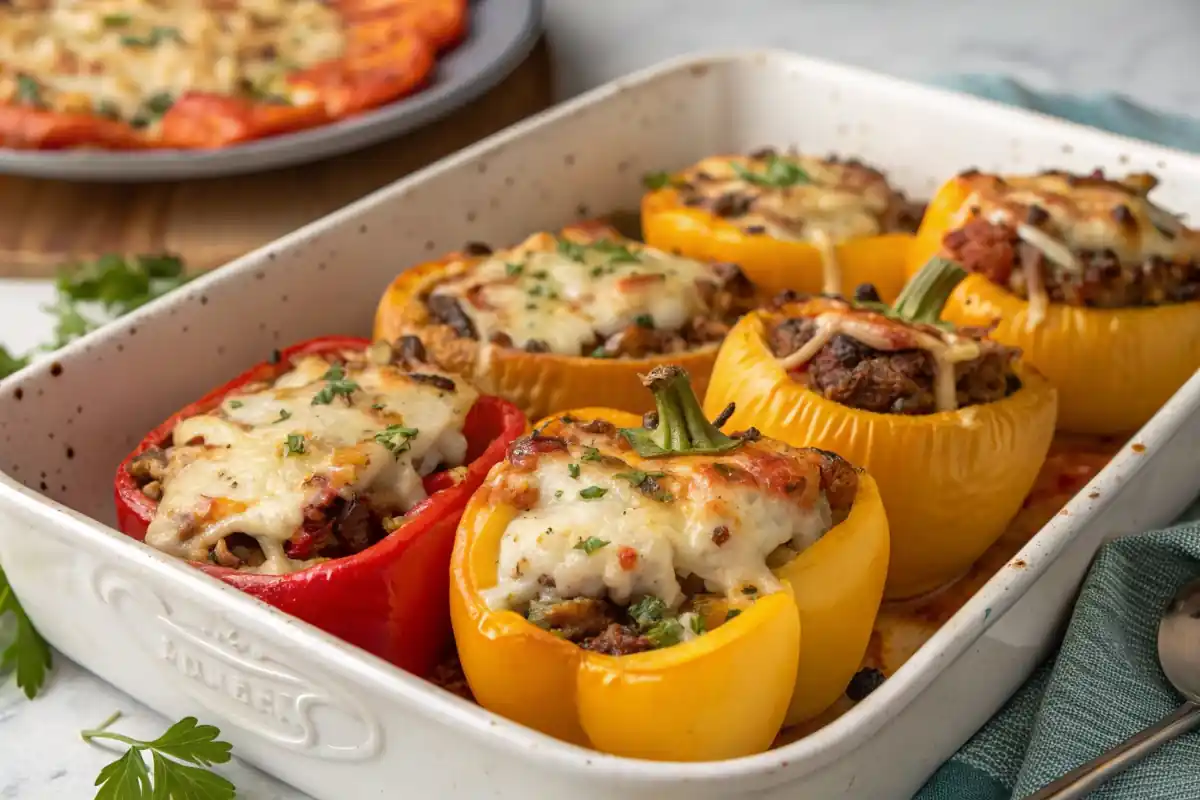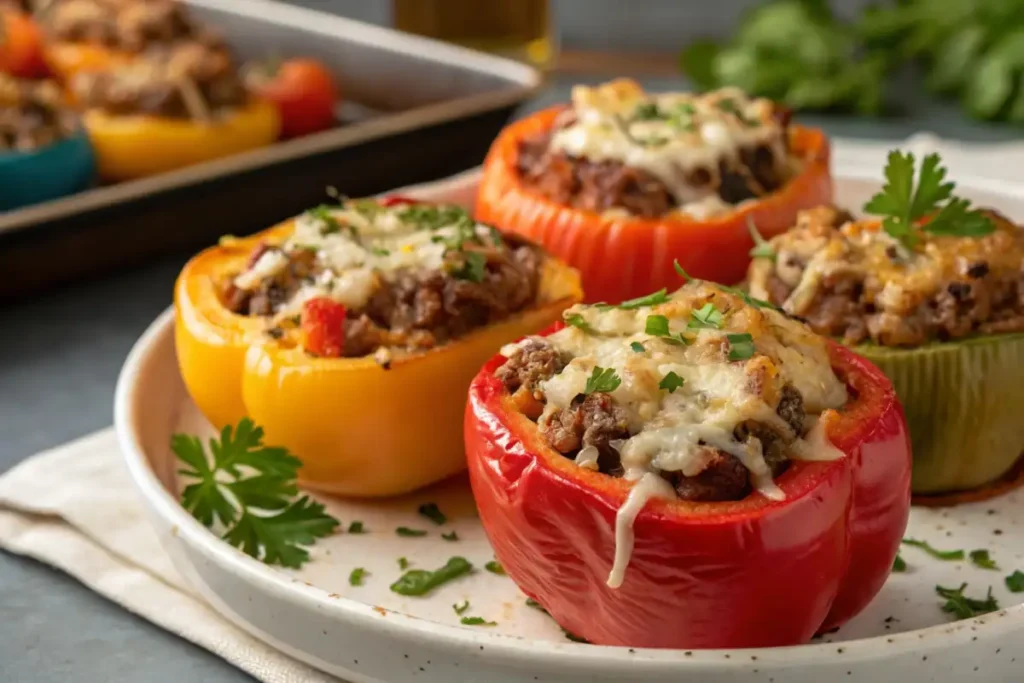Enjoy savory stuffed peppers without rice! This recipe offers a flavorful, healthy twist on a classic. Ready in under an hour!
Why Choose Stuffed Peppers Without Rice?
Stuffed peppers are a classic comfort food. But what if you want to cut back on carbs? Making stuffed peppers without rice is the perfect solution. This version is just as tasty, and even healthier! You get all the flavor with fewer carbs.
Healthier and Just as Delicious
Removing the rice doesn’t mean sacrificing flavor. Instead, you can focus on protein and vegetables. Using lean ground meat, or even ground turkey, keeps things light. Adding more vegetables boosts nutrients. This change can make a significant difference in the overall nutritional balance of the meal. It’s a simple swap that brings a multitude of benefits.
Great for Different Eating Plans
Stuffed peppers without rice are very flexible. They fit into many diets. If you’re limiting carbs, eating gluten-free, or simply want a healthier meal, this recipe works. You can easily adjust the fillings to fit your preferences, too. This makes it a wonderful option for families with diverse dietary needs. You can ensure everyone gets a satisfying and healthy meal.
Stuffed Peppers Without Rice: The Easy-to-Follow Recipe
This recipe breaks down the process, making it simple to create delicious and healthy stuffed peppers without rice.

Ingredients:
- Bell Peppers:
- 4 medium bell peppers (choose a mix of colors for visual appeal: red, yellow, orange, green)
- Ground Meat (or Vegetarian Substitute):
- 1 pound lean ground beef, ground turkey, OR 1 (15-ounce) can of lentils (drained and rinsed) OR 1 pound of chopped mushrooms.
- Vegetables (Aromatic Base):
- 1 medium yellow onion, chopped
- 2 cloves garlic, minced
- Vegetables (Flavor & Texture):
- 1 (14.5-ounce) can diced tomatoes, undrained
- 1 cup chopped zucchini (optional)
- 1 cup chopped spinach (optional)
- 1/2 cup corn kernels (optional)
- Seasoning:
- 1 tablespoon Italian seasoning
- 1 teaspoon paprika
- 1/2 teaspoon salt (or to taste)
- 1/4 teaspoon black pepper (or to taste)
- Pinch of red pepper flakes (optional, for heat)
- Cheese:
- 1 cup shredded mozzarella or parmesan cheese (reduced-fat options work great)
- Tomato Sauce:
- 1 (15-ounce) can tomato sauce (no added sugar is preferred)
- Optional Enhancements:
- Kalamata olives, chopped (for Mediterranean variation)
- Feta cheese, crumbled (for Mediterranean variation)
- Taco seasoning (for Mexican variation)
- Avocado, diced (for Mexican variation)
- Ricotta cheese (for Italian variation)
- Fresh basil, chopped (for Italian variation)
- Breadcrumbs (for Vegetarian variation)
- Quinoa or Farro, cooked (for Vegetarian variation)

Step-by-Step Cooking Instructions:
- Prepare the Peppers:
- Wash the bell peppers thoroughly.
- Cut each pepper in half lengthwise.
- Remove the seeds and membranes from inside each pepper half. A small spoon makes this easier.
- Optional Blanching: If you want softer peppers, blanch them. Bring a large pot of water to a boil. Add the pepper halves and boil for 5 minutes. Immediately transfer them to a bowl of ice water to stop the cooking process. Drain well.
- Make the Filling (Meat Version):
- Heat a large skillet over medium heat.
- Add the ground meat to the skillet and cook, breaking it up with a spoon, until browned.
- Drain off any excess fat from the skillet. This prevents a greasy final dish.
- Add the chopped onion and minced garlic to the skillet with the cooked meat.
- Cook until the onion is softened and translucent, about 5 minutes.
- Add the diced tomatoes (undrained), Italian seasoning, paprika, salt, pepper, and red pepper flakes (if using) to the skillet.
- Stir well to combine all ingredients.
- Bring the mixture to a simmer, then reduce the heat and let it simmer for 10 minutes, stirring occasionally. This allows the flavors to meld together beautifully.
- If using zucchini, spinach, or corn, stir them into the filling during the last 5 minutes of simmering.
- Make the Filling (Vegetarian Version):
- Heat a large skillet over medium heat.
- Add a tablespoon of olive oil (or your preferred cooking oil) to the skillet.
- Add the chopped onion and minced garlic to the skillet.
- Cook until the onion is softened and translucent, about 5 minutes.
- Add the lentils OR chopped mushrooms to the skillet.
- Add the diced tomatoes (undrained), Italian seasoning, paprika, salt, pepper, and red pepper flakes (if using) to the skillet. If adding breadcrumbs, add them now.
- Stir well to combine all ingredients.
- Bring the mixture to a simmer, then reduce the heat and let it simmer for 10 minutes, stirring occasionally. This allows the flavors to meld together beautifully.
- If using zucchini, spinach, or corn, stir them into the filling during the last 5 minutes of simmering.
- Preheat the Oven:
- Preheat your oven to 375°F (190°C).
- Stuff the Peppers:
- Lightly grease a baking dish.
- Spoon the meat (or lentil/mushroom) mixture evenly into each pepper half, filling them generously.
- Place the stuffed peppers in the prepared baking dish.
- Add Tomato Sauce:
- Pour the tomato sauce into the bottom of the baking dish around the peppers. This helps keep the peppers moist during baking.
- Bake:
- Cover the baking dish with aluminum foil.
- Bake for 30 minutes.
- Add Cheese and Finish Baking:
- Remove the foil from the baking dish.
- Sprinkle the shredded mozzarella or parmesan cheese evenly over the stuffed peppers.
- Bake for another 10 minutes, or until the cheese is melted and bubbly and the peppers are tender. Watch carefully to prevent the cheese from burning.
- Let Rest and Serve:
- Remove the baking dish from the oven and let the stuffed peppers rest for a few minutes before serving.
- Serve hot, with your favorite side dishes.
Serving Suggestions:
- A fresh green salad with a light vinaigrette.
- Roasted vegetables (broccoli, carrots, zucchini, etc.).
- A dollop of Greek yogurt or sour cream.
- Whole grain crackers.
Enjoy your delicious and healthy stuffed peppers without rice!thumb_upthumb_down
Creative Variations for Stuffed Peppers Without Rice
Get creative with your stuffed peppers! Try these variations for a new twist.
Mediterranean Stuffed Peppers
Add Kalamata olives, feta cheese, and oregano to the filling. These flavors compliment each other very well. Sun-dried tomatoes are another great addition to this variation.
Mexican Stuffed Peppers
Use ground turkey, black beans, corn, and taco seasoning. Top with salsa and avocado. A sprinkle of shredded cheddar cheese adds extra flavor. Consider using a protein-rich yogurt or sour cream.
Italian Stuffed Peppers
Use Italian sausage, ricotta cheese, and basil. This is a classic combination. A drizzle of balsamic glaze adds a touch of sweetness.
Vegetarian Stuffed Peppers
Use lentils, mushrooms, and spinach. Add a sprinkle of breadcrumbs for texture. Quinoa or farro can be used for added protein.
Enhancing Your Stuffed Peppers: Extra Flavor and Texture
Let’s explore additional ways to elevate your stuffed peppers without rice. These enhancements can make a big difference in taste and overall enjoyment.
Adding Proteins Beyond Ground Meat
While ground meat is a popular choice, there are many other protein sources you can use. Consider adding scrambled eggs to the filling for added protein and a unique texture. Chopped hard-boiled eggs can also work. For a seafood option, try using cooked shrimp or crab meat. These variations can completely change the flavor profile of your stuffed peppers.
Exploring Different Types of Cheese
Mozzarella and parmesan are classic choices, but don’t limit yourself. Try using provolone for a rich, indulgent flavor. Gruyere cheese also melts beautifully and adds a nutty taste. For a tangier option, consider using goat cheese or feta cheese. You can even combine different varieties of cheese for a more complex flavor.
Leveling Up Your Seasoning
Beyond Italian herbs, paprika, salt, and pepper, there are many other seasoning you can experiment with. A dash of Worcestershire sauce adds depth and umami. Smoked salt can enhance the smoky flavor of the peppers. For a spicier kick, try using cayenne pepper or chili powder. Freshly grated nutmeg also adds a warm, subtle sweetness.
The Magic of Mushrooms
Adding mushrooms to your stuffed peppers filling can significantly enhance the flavor and texture. Sautéed cremini or shiitake mushrooms add an earthy, umami note that compliments the other ingredients perfectly. Finely chopped mushrooms can also help to bind the filling together, preventing it from being too loose.
The Art of the Sauce: Drizzling and Dipping
The right sauce can take your stuffed peppers without rice to the next level. Here are a few options to consider:
Balsamic Drizzling
A simple balsamic reduction adds a touch of sweetness and acidity.
Pesto Perfection
A dollop of fresh pesto adds a burst of herby flavor.
Yogurt Sauce
A tangy yogurt sauce with dill and cucumber is refreshing.
Spicy Aioli
For those who like a little heat, a spicy aioli is a great choice.
Complete the Meal: Side Dish Pairings
To create a complete and harmonious meal, consider these side dish pairings with your stuffed peppers without rice:
Refreshing Salad
A refreshing green salad with a light vinaigrette is a classic choice.
Roasted Vegetables
Roasted vegetables like broccoli, carrots, and zucchini compliment the peppers beautifully.
Quinoa
Quinoa offers a protein-rich and nutritious side dish.
Crackers
Whole grain crackers can be served with stuffed peppers.
Understanding Carbohydrates
When following a lower carb diet, understanding carbohydrates is essential.
What Are Carbohydrates?
Carbohydrates are one of the three main macronutrients, alongside proteins and fats. They provide the body with energy.
Types of Carbohydrates
There are simple and complex carbohydrates. Simple carbs are found in sugary foods. Complex carbs are found in whole grain and vegetables.
Limiting Carbohydrates
Limiting carbohydrates can have several benefits, including weight balance. It can also help in maintaining stable blood sugar levels.
Addressing Digestive Concerns
Some people may experience digestive issues after eating certain foods.
Bloating and Gas
Certain vegetables can cause bloating and gas. Cooking them thoroughly can help.
Food Intolerance
Some people may have a food intolerance to certain ingredients. Be mindful of your body’s reactions.
Probiotic Benefits
Adding probiotics to your diet can contribute to increased digestive health.
Serving Stuffed Peppers to Vegetarians
Adapting the stuffed peppers without rice recipe for vegetarians is easy.
Protein Sources
Lentils, mushrooms, and beans are excellent protein sources for vegetarians.
Cheese Options
Ensure the cheese you use is vegetarian-friendly. Some cheese contains animal rennet.
Vegetable Varieties
Experiment with different vegetable varieties to create a satisfying vegetarian meal.
Making it Gluten-Free and Lactose-Free
Adapting the recipe to be gluten-free and lactose-free is simple with a few substitutions.
Gluten-Free Options
Ensure all seasoning and sauces are gluten-free.
Lactose-Free Options
Use lactose-free cheese or a dairy-free alternative.
Reading Labels
Always read food labels carefully to ensure they meet your dietary requirements.
Tips for Conscious Consumers
Conscious consumers are increasingly aware of the environmental impact of their food choices.
Sourcing Ingredients
Prioritize sourcing ingredients from local suppliers and fair trade.
Sustainable Packaging
Look for products with sustainable and recyclable packaging.
Reducing Food Waste
Plan your meals carefully to reduce food waste.
Understanding the Glycemic Index
The glycemic index (GI) measures how quickly a food raises blood sugar levels.
Low Glycemic Ingredients
Choosing low glycemic ingredients can help maintain stable blood sugar levels.
Diabetics and GI
Diabetics should be particularly mindful of the glycemic index of the foods they eat.
Sustained Energy
Low glycemic foods provide sustained energy.
Stuffed Peppers: A Culinary Adventure
Stuffed peppers without rice offer a sophisticated culinary experience.
Exploring Flavors
Experiment with different ingredients and seasoning to discover your perfect combination.
Pairings
Explore different side dishes and sauces to create a complete meal.
Celebrating Freshness
Embrace the freshness of seasonal ingredients.

Embracing Seasonal Eating with Stuffed Peppers
One of the best ways to elevate your stuffed peppers without rice is to embrace seasonal eating. Using ingredients that are in season not only enhances the flavor but also supports local farmers and reduces your environmental impact. Here’s how you can adapt your stuffed pepper recipe to the seasons:
Spring Stuffed Peppers
In the spring, focus on fresh, light ingredients. Asparagus, peas, and fresh herbs like dill and mint can add a refreshing touch to your filling. Consider using ground lamb for a slightly richer flavor that compliments the spring vegetables.
Summer Stuffed Peppers
Summer is the perfect time to take advantage of fresh, ripe tomatoes, zucchini, and bell peppers. Corn and black beans can add a touch of sweetness. Consider using grilled chicken or turkey for a lighter protein option.
Autumn Stuffed Peppers
Autumn brings a bounty of root vegetables like butternut squash, sweet potatoes, and parsnips. These can be roasted and added to your filling for a hearty, warming flavor. Mushrooms are also in season during the fall, adding an earthy depth to your stuffed peppers.
Winter Stuffed Peppers
In the winter, focus on heartier ingredients that can withstand the cold. Root vegetables like carrots, turnips, and potatoes can be used in your filling. Consider adding dried fruits like cranberries or apricots for a touch of sweetness.
Additional Tips for Environmental Responsibility
Beyond sourcing seasonal ingredients, there are several other ways to make your stuffed peppers without rice more eco-friendly:
Reduce Meat Consumption
Consider using plant-based proteins like lentils or beans. This can significantly reduce your carbon footprint.
Buy in Bulk
Purchasing ingredients in bulk reduces packaging waste.
Compost Food Scraps
Composting food scraps like vegetable peels reduces landfill waste.
The Nutritional Benefits
These stuffed peppers are not just delicious. They’re also packed with nutrients.
Protein Powerhouse
The ground meat provides protein, which is essential for muscle building.
Vitamins and Minerals
The vegetables offer plenty of vitamins and minerals. Bell peppers are rich in Vitamin C. Tomatoes provide antioxidants.
Low Carb Option
Without rice, these peppers are a lower carb alternative.
Making Stuffed Peppers Without Rice Ahead of Time
These peppers are great for meal prepping.
Storing and Reheating
You can prepare the stuffed peppers ahead of time. Store them in the refrigerator for up to 3 days. To reheat, bake them in the oven at 350°F (175°C) until heated through. You can also microwave them, but they might not be as crispy.
Freezing Stuffed Peppers
Stuffed peppers can also be frozen. Wrap them individually in plastic wrap. Then, place them in a freezer bag. They can be stored in the freezer for up to 2 months. Thaw them in the refrigerator overnight before reheating.
More Vegetable-Forward Recipes
Looking for more ways to enjoy vegetables? Try these recipes.
Zucchini Noodles with Pesto
This is a refreshing and light alternative to pasta.
Roasted Broccoli with Garlic
A simple and flavorful side dish.
Cauliflower Rice Bowl
A healthy and satisfying meal.
Frequently Asked Questions (FAQs)
What goes well with stuffed peppers?
A simple side salad, roasted vegetables, or a cucumber and tomato salad compliment stuffed peppers nicely.
Should I boil peppers before stuffing them?
Boiling, or blanching, the peppers is optional. It softens them and reduces the cooking time. If you prefer a crisper pepper, skip this step.
Do you put rice in pepper?
Traditionally, yes. But this recipe focuses on stuffed peppers without rice, offering a lower carb and vegetable-rich option.
How do you make stuffed peppers not watery?
Drain excess liquid from the meat mixture. Bake the peppers on a wire rack. Lightly salt the inside of the peppers before stuffing them.

